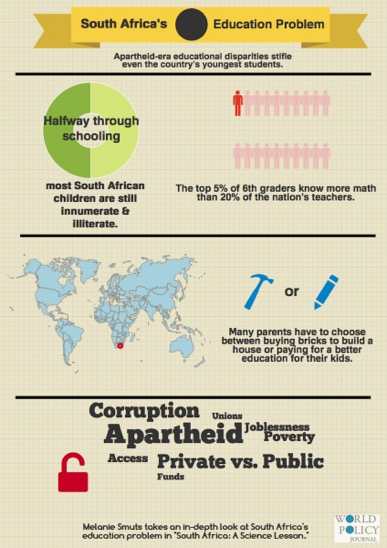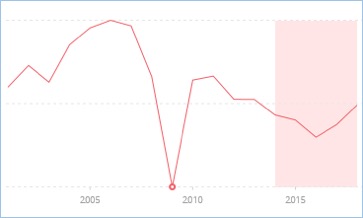Abstract
In the two decades since the end of Apartheid, the international community has perceived South Africa to be the most influential country in Sub-Saharan Africa. The country continues to play an important economic role on the continent and is a driving political force in the African Union (AU). As such, South Africa has received recognition as an important emerging power and gained access to key international platforms, including the United National Security Council, the G20, and the BRICS (Brazil, Russia, India, China, and South Africa) forum (German Development Institute, 2016).
However, in recent years, South Africa’s position as the continental power has been challenged by fast growing African economies such as Ethiopia, Nigeria, and Kenya. This paper argues that South Africa’s poor education system is the primary cause for the country’s economic slowdown. I examine how South Africa’s current role in the African economy has been affected by its pre- and post-Apartheid education policies. I discuss how the negative effects of the education system will determine South Africa’s future role in the African economy. I explore policies that the South African government has implemented in order to mitigate these negative effects on the labour force. Finally, I reflect on the Wharton MBA group trip to meet the Khayelitsha Entrepreneurship Group and the impact entrepreneurship could have on the South African economy.
The Education System in South Africa
The economic stagnation that South Africa has experienced in the last decade, as well as questions regarding its current role in the African economy, are both inextricably linked to the failure of its education system. South Africa spends roughly 6% of its gross domestic product (GDP) on education, more than any other African country, yet ranks at the bottom of all middle-income countries in math, science, and literacy. Within Africa, the country performs worse than poorer nations, such as Zimbabwe, Tanzania, and Swaziland. The situation is so dire that according to TIMSS (Trends in International Mathematics and Science Study), a third of South African school children tested in 2011, performed worse than if they had guessed the multiple choice answers to questions. A recent study by Nicholas Spaull of Stellenbosch University concluded that the top 5% of South African sixth graders know more about mathematics than 20% of the country’s teachers (Smuts, 2014). There are two primary causes of this systemic failure: the lasting effects of Apartheid-era education policies and the corrupt education bureaucracy.
Apartheid-Era Education System, 1948-1994
For much of the first half of the 20th century, black students attended independent schools set up by Catholic and Anglican churches, which provided schooling of the same quality that white students received in state schools. In 1953, the South African government passed the Bantu Education Act, which eliminated almost all financial aid to these independent religious schools, causing many to either sell to the government or to close entirely. While it did provide large-scale and centrally administered schooling for black students, the quality of teaching was inferior to the instruction white students received. The Bantu curriculum was designed to prepare black students for low-level, menial jobs (Smuts, 2014).
Problems in the education system only worsened in the 1970s. In 1974, the Afrikaans Medium Decree was issued, which made the use of English and Afrikaans compulsory in black secondary schools and greatly reduced the time spent receiving instruction in the native language. For example, the sciences would be taught in English, mathematics and social sciences in Afrikaans, and music and cultural subjects in native languages. This placed black students at a severe disadvantage relative to white students and led to increased anger over the language policy and the poor quality of Bantu education. Tensions finally erupted in 1976, when thousands of students from the Soweto township conducted a peaceful protest against these education policies. The South African government escalated the situation by sending in the police, ultimately resulting in hundreds of student deaths. In the years following the Soweto Uprising until the end of Apartheid in 1994, education quality, accountability, and credibility further declined in black schools (Smuts, 2014).
Post-Apartheid Education System, 1994-Present
The election of Nelson Mandela as South Africa’s first black president after three centuries of white rule, ushered in an era of hope of equal education for all students. However, this proved to be far more difficult than anyone had realized. The newly elected government sought to discard all Apartheid-era institutions and systems, education being one of them. The Department of Basic Education (DBE) introduced outcomes-based education (OBE), a system that was essentially the polar opposite of the Bantu system. The focus of OBE was on the student, not content, and everyone was encouraged to express an opinion rather than undertake rote learning. The system tried to “democratize” the relationship between students and teachers; instead of teaching a topic, teachers simply facilitated lessons. Teachers were actively discouraged from using textbooks as sources of knowledge, creating little incentive for students to learn how to read. As a result, many students graduated secondary school almost illiterate and were subsequently rejected by universities (Rusznyak, 2014).
The corrupt education bureaucracy in South Africa is largely to blame for further exacerbating problems facing the education system. A study titled “Identifying Binding Constraints in SA Education,” produced by education experts affiliated with the University of Stellenbosch’s Research on Socio-Economic Policy unit, states “The binding constraints approach argues that some problems are so severe that, unless they are first resolved, no amount of money or time spent solving the less severe problems will help” (Masondo, 2016). The study names three core binding constraints that undermine efforts to implement higher levels of accountability in the education system, which include weak institutional functionality, poor teacher content knowledge, and insufficient learning time for pupils.
It can be argued that the catalyst for all three binding constraints is the ongoing battle between the South African Democratic Teachers’ Union (Sadtu), the country’s largest and most influential teachers’ union, and the Department of Education (DOE). The Stellenbosch study found that in many schools, less than half of the official curriculum was being covered by the end of the school year and fewer than half of the officially scheduled lessons were being taught. The researchers identified inadequate teaching time, teacher absenteeism, and insufficient opportunity for students to learn as the reasons behind these statistics, the blame of which can be placed squarely on the teachers’ shoulders (Masondo, 2016).
The DOE has attempted to remedy the situation by introducing various initiatives, all of which have been subsequently rejected by Sadtu. Some of the methods that the department has introduced to increase teacher accountability, include testing teachers’ and principles’ competencies, periodic evaluations of teachers, performance contracts for principals, biometric clocking systems to monitor teacher attendance, pay linked to performance, making education an essential service in each province, and introducing curriculum inspectors. Sadtu has refused to negotiate and has demanded improved pay, benefits, and conditions of work. As the report states, “Sadtu remained strongly opposed to national policies implementing any forms of monitoring or control of teachers’ work, even where accountability systems were disconnected from punitive measures” (Masondo, 2016).
Sadtu, on the other hand, have little reason to trust in the competency of the DOE, as corruption has been ingrained within the department in the two decades following the end of Apartheid. Pass rates for the National Senior Certificate (NSC), the exam that determines whether a student completes his or her secondary education, have steadily risen since 1994 despite the rampant failings within the education system. In 2014, the most recent election year, the NSC pass rate was 78.2%, conveniently exceeding the target of 75% (Molefe, 2014). This fact hides two critical failures of the system. First, pass rates are calculated with only those Grade 12 students who actually took the exams. Census estimates reveal that only 48% of students who begin Grade 1 actually complete Grade 12, with the majority of students dropping out in Grades 10 and 11. Due to the fact that schools are graded based on their NSC pass rates, under-performing schools have every incentive to discourage weaker students from taking the exam so as to not negatively impact the statistic. Second, the pass rates are skewed higher because the subject passing threshold is so low, only 30% in some subjects. In order to pursue a university degree, a student must obtain over 50% in at least four designated subjects, a mark that only 30.6% of public school students achieved (Rusznyak, 2014). The system is setting the bar low enough to push students through, yet not preparing them for higher education or careers in technical fields. The government has resorted to giving out incentives and subsidies to employers who provide first-time workers with intensive training and skills-development programs, effectively “passing the buck” from the public to the private sector (Molefe, 2014).
There have been some initiatives to improve the quality of education in South Africa. These range from collaborations between underperforming schools and universities, learning-focused TV channels, and non-governmental organizations (NGOs) such as the READ Educational Trust (Rusznyak, 2014). Affordable private schools, also known as low-fee schools or low-cost private schools, may provide a large part of the answer. These schools are owned and operated by non-state players and provide access to high-quality schooling for low- and middle-income families who have grown frustrated with state education. Since parents contribute financially towards tuition, affordable schools are directly accountable to parents. If parents are not happy with the education their children are receiving or if they feel that the schools are not delivering the value for the money, they can transfer their children to cheaper government alternatives. This dynamic increases teacher attendance and performance and reduces administration corruption. Most importantly, there is less widespread unionization in affordable schools and stricter management practices (Smuts, 2014).
The Wharton group saw the impact private schools can have on South Africa, as well as Africa as a whole, when visiting the African Leadership Academy (ALA) in Johannesburg. Chris Bradford, co-founder and CEO, spoke about the five founding beliefs of the school. First, they are focused on addressing the underlying causes of problems in Africa, which they believe is a lack of leadership across all sectors. Two, they believe in the power of one, where a single leader can be the catalyst for massive societal positive change. Three, they believe in the power of youth, which recognizes that some of the world’s greatest leaders began to change the world at a young age. Four, they recognize the need for Pan-African cooperation, which will be the catalyst for growth and development across the continent. Five, they believe that entrepreneurship is fundamental to growth, and teach the young African leaders not to rely on existing government institutions.
Private schools, as well as an overall improvement in the quality of education, will be critical in defining South Africa’s future role in the African economy. In an interview with CNN, Fred Swaniker, ALA co-founder and Executive Chairman, summarizes why he set out to found the academy, saying “I realized leadership was the single biggest thing that was holding us back from achieving our potential as a continent” (Howell, 2016). South Africa has a wealth of talent, and the purpose of an education system is to develop and nurture that talent. However, it will take the development of strong leadership in schools like the ALA to align the competing interests in the education system so that South Africa can realize its economic potential.
The Lasting Effects of the South African Education System
Since the end of Apartheid, human development indicators in South Africa have presented a contrasting picture of the country. Non-income indicators of welfare, such as access to housing, water, sanitation, and electricity, have improved, while income indicators such as wage levels, household income, and unemployment have continued to fall behind (Bhorat, Hirsch, Kanbur, & Ncube, 2014). Inequalities in the returns on skills, unemployment, low labour productivity, and low labour income in the self-employed informal sector are the results of the country’s poor education system. As a result, the South African government has had to increase spending on various supply-side and demand-side initiatives aimed at reducing unemployment, especially among young workers.
Lack of Education as a Cause of Structural Unemployment
The severe inequalities in primary and secondary schooling between rich and poor areas of South Africa limit the returns to education. Whereas access to education has increased following the end of Apartheid, students often leave secondary school without the necessary skills to transition into university. Universities are not producing sufficient graduates in key skill categories and vocational and technical training colleges produce only a relatively small number of suitable graduates (Bhorat, Hirsch, Kanbur, & Ncube, 2014). This constant mismatch between what companies need and what workers can offer is the very definition of structural unemployment, which contributed to South Africa’s limited economic growth in the last decade.
Education can only have an effect on income once a person becomes employed and the lack of employment opportunities has limited the returns on skills. South Africa had an unemployment rate of 34% as of 2014, far higher than other economically-comparable emerging markets. Roughly one-third of 15- to 24-year-olds are not in employment, education, or training. Along with the lack of skills after leaving school, many young South Africans do not have the social networks that allow them to source job opportunities and the financial resources to move to areas where there is a demand for labor (Cassim & Oosthuizen, 2014). Of those who do have financial support, many young workers have unrealistically high reservation wages, or the wages being offered that would induce the unemployed to move to employment. In fact, one study found that after controlling for other factors, more than three quarters of males and more than half of females have stated desired wages above those they could get with their skills and background in a moderate-sized firm (Bhorat, Hirsch, Kanbur, & Ncube, 2014). Such unrealistic expectations are likely the result of the lack of real-world work experience and internship opportunities for many young people.
Supply-Side Policies Targeting Youth Unemployment
One method the South African government has used to reduce youth unemployment is to set up a number of skills and training programs to fund technical and vocational education and training (TVET) institutions, the goal of which is to facilitate entry into the labour market. However, these institutions have been unable to meet student capacity and meet the types of training required by employers. For example, TVET institutions are not easily accessible in terms of location or financing for many young people without financial support from friends and family. They also do not provide training in non-vocational skills that both employees and employers require. As a result, partnerships between TVET institutions and employers are weak at best, offering students little opportunity for internships and employment after graduation (Cassim & Oosthuizen, 2014).
Another method used by the government to increase the supply of labour was through public sector employment opportunities. In 2008, the Community Works Programme (CWP) was enacted and was designed as an employment safety net whereby a person’s existing livelihood was supplemented by offering a basic level of income through work. This programme targeted the poorest communities in the country and served as a complement to the social grant system. Each community determined the types of work created through the programme by deciding what activities would benefit them most. However, the CWP did little to reduce youth unemployment due to the menial nature of the work, such as repairing school infrastructure, creating food gardens, or home-based care. Therefore, the skills acquired did not lead to better paying jobs in the labour market, especially in urban areas (Cassim & Oosthuizen, 2014).
Demand-Side Policies Targeting Youth Unemployment
The South African National Treasury has suggested that the high youth unemployment rate is a result of insufficient demand in the labour market to absorb the increasing number of job seekers each year. To counteract this trend, the National Treasury has proposed a youth employment subsidy, which would indirectly incentivize employers to hire more first-time workers. An employment subsidy is more efficient than the supply-side options since it operates through the tax system and is easily scalable. Employers who hire first-time workers will be subsidized for two years, with a larger proportion of wages being subsidized in the first year (Cassim & Oosthuizen, 2014).
Such supply-side initiatives have since yielded positive results. In 2014, the African Microeconomic Research Umbrella at the University of Witwatersrand ran a pilot study with 4,000 participants from three provinces (Gauteng, Kwazulu-Natal, and Limpopo). For the experiment, half of the sample was given vouchers to cover up to 50 percent of their wages for six months, while the remainder of the sample was given nothing. The study found that job seekers who had received vouchers were more likely to stay in a job for more than two years (Cassim & Oosthuizen, 2014). This study illustrates the positive multiplier affect these initiatives can have in reducing youth unemployment.
Entrepreneurship in South Africa
Economies in which individuals lack the education and skills needed for employment, or whose government policies have failed to create the economic growth necessary to absorb individuals into the workforce, often see a high rate of entrepreneurial activity. South Africa’s rate of entrepreneurial activity, despite an unemployment rate of 34%, is only a quarter of that seen in other sub-Saharan African countries (Global Entrepreneurship Monitor, 2014). Dr. Jonathan Marks, Head of Faculty at the Gordons Institute for Business Science (GIBS) states:
“Entrepreneurship is a complex phenomenon. South Africa does not perform particularly well in relation to the rest of the globe. If one looks at the Global Entrepreneurship Monitor report, it indicates that we have around 7% of the adult population involved in entrepreneurship at any one time” (702, 2015).
The GIBS study identifies onerous labour laws, low labour productivity, government corruption, and crime as the main causes of the low entrepreneurial activity in the country.
The Wharton group’s visit to the Khayelitsha Entrepreneurship Group provided them with a first-hand account of entrepreneurial activity in South Africa’s townships, as well as a counterbalance to the above statistics. They met several entrepreneurs, including the founder of a spinach-focused bakery (“The Spinach King”), an on-demand coffee provider (“Department of Coffee”), a singing group (“Heavenly Quartez”), an after-school swim program, and a laundry service. Each founder explained how their motivation for starting a company stemmed from the fact that they understood that the government or school system would not provide them with the necessary opportunities to succeed. They also described how their feeling of accomplishment came not from earning a livable wage for themselves, but from creating jobs for their community. This visit was incredibly inspirational and was probably the highlight of the author’s trip. It made him realize how much untapped talent South Africa has and how much of a positive impact entrepreneurs could have on the economy.
Conclusion
The failure of South Africa’s education system has had a profound impact on the country’s current role in the African economy. Destructive Apartheid-era education policies, as well as the corrupt education bureaucracy, have created a system that fails the majority of South African students and weakens the labour force. Many students leave secondary and tertiary school without the necessary skills required by employers. The South African government has tried to reduce the cycle of structural unemployment through government programmes and employment subsidies, to varying degrees of success. Such a non-competitive labour force will have lasting negative effects that will ultimately dictate South Africa’s future role in the African economy.
This report was presented to the NTU-SBF Centre for African Studies for publication. The Centre is a trilateral platform for government, business and academia to promote knowledge and expertise on Africa, established by Nanyang Technological University and the Singapore Business Federation.
Matt is in the process of founding Isoquant Media, LLC, an early-stage financial engineering start-up that provides bespoke financial products to the media industry to protect against volatility in ratings, viewership, and impressions. Prior to pursuing his entrepreneurial dream, Matt was an Investment Banking Associate at Progress Partners, a boutique M&A and corporate advisory firm specializing in the software, marketing, media, and advertising sectors. Matt has over 10 years of experience in the finance industry and has held positions in treasury and cash management, equity research, corporate financial planning and analysis, and structured finance. Matt graduated from George Washington University in 2004 with a Bachelors of Business Administration in finance and a minor in economics. He is a Chartered Financial Analyst (CFA), a certified Financial Risk Manager (FRM), and a Certified Treasury Professional (CTP). Matt is currently pursuing his Masters of Business Administration at the Wharton School at the University of Pennsylvania.
References
- (2015, July 30). The State of Entrepreneurship in South Africa. Retrieved from 702: http://www.702.co.za/articles/4179/the-state-of-entrepreneurship-in-south-africa
Bhorat, H., Hirsch, A., Kanbur, R., & Ncube, M. (2014). Economic Policy in South Africa: Past, Present, and Future. Cape Town: Development Policy Research Unit.
Cassim, A., & Oosthuizen, M. (2014, August 15). The State of Youth Unemployment in South Africa. Retrieved from Africa in Focus: https://www.brookings.edu/blog/africa-in-focus/2014/08/15/the-state-of-youth-unemployment-in-south-africa/
German Development Institute. (2016). Emerging Power or Fading Star? South Africa’s Role on the African Continent and Beyond. German Development Institute. Cape Town: https://www.die-gdi.de/en/events/south-africas-role-on-the-african-continent-and-beyond/. Retrieved from https://www.die-gdi.de/en/events/south-africas-role-on-the-african-continent-and-beyond/
Global Entrepreneurship Monitor. (2014). An Alarmingly Low Level of Entrepreneurial Activity in Spite of High Unemployment. Retrieved from GEM Consortium: http://www.gemconsortium.org/country-profile/108
Howell, R. (2016, September 6). From Teenage Headmaster to Building the “Harvard” of Africa. Retrieved from CNN: http://edition.cnn.com/2016/09/06/africa/fred-swaniker-teacher-leadership-africa/index.html?iid=ob_homepage_featured_pool
Masondo, S. (2016, May 31). Education in South Africa: A System in Crisis. Retrieved from City Press: http://city-press.news24.com/News/education-in-south-africa-a-system-in-crisis-20160531
Molefe, T. (2014, January 15). South Africa’s Failing Grade. Retrieved from New York Times: http://www.nytimes.com/2014/01/16/opinion/molefe-south-africas-failing-grade.html?_r=1
Nkosi, M. (2016, January 29). Is South Africa’s Education System Really “In Crisis”? Retrieved from BBC News: http://www.bbc.com/news/world-africa-35427853
Rusznyak, L. (2014, May 7). South African Education Still Fails Many 20 Years After Apartheid. Retrieved from The Conversation: http://www.bbc.com/news/world-africa-35427853
SA Vision 2020. (2016, March 3). Global Entrepreneur Monitor Report. Retrieved from SA Vision 2020: http://savision2020.org.za/2016/03/03/global-entrepreneur-monitor-report/
Smuts, M. (2014, May 9). South Africa’s Education Problems. Retrieved from World Policy: http://www.worldpolicy.org/blog/2014/05/09/infographic-south-africas-education-problem
Appendix
Exhibit 1. South Africa Education Infographic
Exhibit 2. South Africa Historical GDP
Source: World Bank
Exhibit 3: South Africa Projected GDP Growth %
Source: World Bank
Exhibit 4: Math and Science Education Rankings by Country
Source: 2015 World Economic Forum (WEF)






